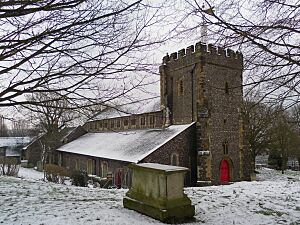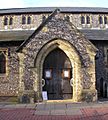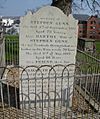St Nicholas Church, Brighton facts for kids
Quick facts for kids St. Nicholas of Myra, Brighton |
|
|---|---|

View of St Nicholas Church from the churchyard
|
|
| 50°49′31.29″N 0°8′41.47″W / 50.8253583°N 0.1448528°W | |
| Location | Church Street, Brighton, East Sussex BN1 3LJ |
| Denomination | Church of England |
| Previous denomination | Catholic |
| Churchmanship | Affirming Catholic |
| Website | St. Nicholas, Brighton |
| History | |
| Dedication | St. Nicholas of Myra |
| Administration | |
| Parish | Brighton, St Nicholas |
| Deanery | Brighton |
| Archdeaconry | Chichester |
| Diocese | Chichester |
| Province | Canterbury |
St. Nicholas Church, also known as the Church of Saint Nicholas of Myra, is a historic Anglican church in Brighton, England. It was the very first parish church for Brighton. It is also one of the oldest buildings still standing in the city of Brighton and Hove. Only St Helen's Church, Hangleton and St Peter's Church in Preston village are older.
You can find the church on a hill where Church Street and Dyke Road meet, right in the city centre. It's very close to the main shopping areas. Because of its important design and history, the church is a Grade II* listed building. This means it's a special building protected by law.
Contents
A Look at Early History
The Domesday Book of 1086 mentions a church in Bristelmestune, which was the old name for Brighton. This church was worth £12 back then. Soon after, it was given to the Cluniac priory in nearby Lewes.
We don't know for sure where this first church was located. However, it's possible it stood right where St. Nicholas Church is today. The original village was closer to the coast, but that area was wet and often damaged by the sea. It was also easy for invaders to attack. The higher ground where the church now stands would have been safer. It was also easy to see for villagers and fishermen at sea.
Building the Church We See Today
The St. Nicholas Church you see now was mostly built in the mid-1300s. Inside, there's a special font from around 1170. This old font was moved to the west end of the church in 2001. It has been moved several times over the centuries.
When it was first built in the 1300s, the church had a large tower at the west end. It also had a chancel (the area around the altar) and a nave with aisles (the main part where people sit). Later, in the 1400s, a chantry was added. Chantries were small chapels where prayers were said for the dead. These were common additions back then.
Surviving Attacks and Storms
In June 1514, French raiders attacked Brighton. They burned the entire village, which was then called Brighthelmstone. Only the church survived because it was further inland and on higher ground, away from the fire.
The church was also damaged by two big storms. In November 1703, the Great Storm of 1703 ripped lead from the roof. Then, in August 1705, another storm blew off all the remaining lead sheets. A special stone tablet, dated 1705, was placed in the new roof to remember this event.
Growing Popularity in the 1700s
Later in the 1700s, Brighton's population started to grow. More and more people came to the town. To fit everyone, new rows of seats, called pews, were added inside the church. These pews spread out from the font in the middle.
Brighton became very popular after Dr. Russell said that seawater was good for your health. Later, the Prince Regent also visited often, making the town even more fashionable. St. Nicholas was the only Anglican church in Brighton at the time. It became so crowded that galleries (extra seating areas) had to be built around the roof. You had to use outside staircases to reach them.
Today, you can see a model of how the church looked inside before it was rebuilt in 1853. This model is in one corner of the church.
Who Looked After the Church?
From the late 1000s until 1537, the ancient Southover Priory in Lewes was in charge of the church. In 1537, the last prior gave it to the Crown (the King or Queen). In 1540, it went to Thomas Cromwell, 1st Earl of Essex. After he died in 1540, the right to choose the church's priest, called the advowson, was given to Anne of Cleves in 1541. Finally, in 1558, the Bishop of Chichester gained control. The Bishop of Chichester has been the church's patron ever since.
The Big Rebuilding in 1853
Brighton changed a lot when King George IV was on the throne (1820-1830). The town remained very popular, and the number of houses doubled. By 1830, eight smaller churches, called chapels of ease, had been built. These helped reduce the crowds at St. Nicholas Church. However, St. Nicholas remained popular because it was free to attend.
The church's local committee, called the administrative vestry, had trouble raising money to fix the church. They often disagreed with the vicar, Rev. Henry Michell Wagner. This meant the church became quite run-down, and some windows even had to be boarded up.
A Memorial to a Hero
The problem was solved in 1852 when the Duke of Wellington, Arthur Wellesley, passed away. The Duke had connections to Rev. Wagner and St. Nicholas Church. As a child in the 1780s, he studied at a school run by Rev. Wagner's grandfather. He also attended St. Nicholas Church to worship. Later, Rev. Wagner himself taught the Duke's sons for eight years.
Because of these connections, Rev. Wagner decided to start a fund to rebuild the church as a memorial to the Duke. He gave the first £1,000 himself. People then donated almost £5,000 more.
The Architect and the Work
The architect chosen for the rebuilding was Richard Cromwell Carpenter. He was known for his work with the Cambridge Movement and Tractarianism, which focused on traditional church design. Permission to demolish and rebuild was given on April 15, 1853.
Carpenter and the building company, Bushby's of Littlehampton, worked very quickly. The church reopened on April 8, 1854, only about nine months after work began.
The rebuilding included many changes:
- A new roof was installed.
- The aisles (side sections) were made twice as wide.
- The chantry chapel was made smaller.
- A new organ-chamber and a new east window were added.
- All the old galleries and box-pews were removed.
- The font was moved near the south door.
- A stone cross was put in place to remember the Duke of Wellington.
The reconstruction cost £5,769. It reduced the church's seating capacity by about 30% to around 900 people because the galleries were removed. Richard Cromwell Carpenter passed away just a year after the project was finished.
Changes Over the Years
Much work was done on the church over the next fifty years. Most of these were additions or replacements of existing parts. Sadly, some of the church's original mediaeval features were lost or changed.
New Pulpit and Organ
Somers Clarke, who worked for the church's administrative committee for 62 years, gave a new pulpit to the church in 1867. The old pulpit had been replaced with a smaller wooden one during the 1853 rebuild. Clarke's new pulpit was made of iron. A new organ, costing £500, was installed in 1872. A new vestry (a room for the clergy) was built between 1876 and 1877, north of the chancel.
Stained Glass Windows
Between 1878 and 1887, many beautiful stained glass windows were designed and installed. The famous designer Charles Eamer Kempe created many of these. He was a cousin of Thomas Read Kemp, who developed Brighton's Kemp Town area. Somers Clarke also donated a window to remember Rev. Wagner, who had passed away in 1870. During this time, the east window installed by Carpenter was replaced with a new one in the Perpendicular style. The original window was moved to the Church of the Annunciation in the Hanover area.
Raising the Roof
A big change happened in 1892. The entire roof was removed and lifted higher using machines. This created more space inside the church. The new space was filled with clerestory windows, which are windows placed high up on the walls. Charles Eamer Kempe also added various paintings and murals to the new internal space.
The 15th-century chantry chapel was changed again in 1900. It had been made smaller in 1853, but it was enlarged once more. In 1909, it was turned into a Lady chapel, a chapel dedicated to the Virgin Mary.
The Church Bells
The first set of ten bells was given to the church in 1777 by Thomas Rudhall. His family was famous for making bells for 700 years in Gloucester. These bells were put in the tower at the west end of the church.
Two of these bells were given to St. Peter's Church when it was finished in 1828. However, in 1892, a former church warden left money in his will to buy two new bells to replace them. Then, in 1922, a completely new set of ten bells was installed by Gillett and Johnson.
It became a tradition to ring the bells when important visitors came to Brighton, especially kings, queens, or other members of the Royal Family. Special stone tablets at the base of the ringing chamber list these "special occasions." For example, the bells were rung for Queen Victoria's Golden Jubilee in 1887. More recently, the bells were rung in a special way for the funeral of Henry Allingham on July 30, 2009.
The Churchyard and Its Famous Graves
St. Nicholas Church is surrounded by an old graveyard with many tombs. No new burials have taken place here for many years. The council landscaped the area in the mid-1900s, but most of the important historical tombs were left untouched. All the monuments mentioned below are Grade II listed.
Captain Nicholas Tattersell
The oldest memorial belongs to Captain Nicholas Tattersell. In 1651, he helped King Charles II escape from Shoreham harbour to France. He used his coal ship, Surprise. You can read more about the King's escape from the Battle of Worcester and his journey to Fécamp in Normandy. When King Charles returned to Britain in 1660, he gave Tattersell a pension of £100 per year. The Surprise ship was also added to the Royal Navy's fleet and renamed The Royal Escape.
Phoebe Hessel
Phoebe Hessel was a famous resident of Brighton in the 1700s and 1800s. When she was 15, she fell in love with a soldier named William Golding. When he was sent overseas, she disguised herself as a man to join the British Army alongside him. She kept her secret for 17 years! Even after being wounded in the arm at the Battle of Fontenoy in 1745, no one found out during her treatment. She only told her commanding officer's wife herself and was then discharged.
After Golding died in the 1760s, she moved to Brighton and became very well-known. She lived to be 108 years old! The Prince Regent gave her a special pension, and she even rode in his procession when he became King George IV.
Martha Gunn
Martha Gunn, another well-known Brighton resident from the 1700s and 1800s, is also buried in the churchyard. She was the most famous of Brighton's dippers. Dippers helped people who couldn't swim bathe in the sea using horse-drawn bathing machines. Dippers had to be the same sex as their client. Martha Gunn was highly respected for many years by locals and visitors. Her strength was a big help in this difficult job.
Anna Maria Crouch
Anna Maria Crouch, a famous singer and actress from the same time as Hessel and Gunn, has an impressive stone urn marking her grave. She performed in many plays at the Theatre Royal, Drury Lane in London. She was also known for her interesting life, including a connection with the Prince Regent. She passed away in 1805 at the age of 42.
Other Notable Burials
Other important people from Brighton's history buried here include Sake Dean Mahomet. He was an Indian man who brought the Indian curry house restaurant to Great Britain. He also started "shampooing" baths and became the shampooing surgeon to King George IV and William IV.
Amon Wilds, a key architect of the Regency era, who designed many of Brighton's famous buildings, is also buried here. Meanwhile, Dame Flora Robson, a famous actress known for her long career on stage, TV, and film, has a memorial stone in the churchyard. She lived near the church until she passed away in 1984.
Expanding the Churchyard
The churchyard was first made bigger in 1824, across Church Street to the north. This area has since been turned into a playground. Another small expansion happened in 1831. The biggest change came in 1841 when land to the west of Dyke Road was bought. This became a much larger burial ground. This western part was designed by Regency architect Amon Henry Wilds. It contains several burial vaults that are also Grade II listed.
St. Nicholas Church Today
St. Nicholas Church was given Grade II* listed status on October 13, 1952. As of February 2001, it was one of 70 Grade II*-listed buildings in the city of Brighton and Hove.
For many centuries, St. Nicholas Church was Brighton's main parish church. However, it lost this status in 1873. The Bishop of Chichester changed how Brighton's parishes were organized. St Peter's Church had been built in 1828 as a smaller church connected to St. Nicholas. In 1873, the two churches became separate, each with its own parish. St. Peter's became Brighton's new parish church, perhaps because it was more central as the town grew. Even so, St. Nicholas Church is still widely known as "The Mother Church of Brighton."
Photo gallery
See also
- Cemeteries and crematoria in Brighton and Hove
- List of places of worship in Brighton and Hove
- List of works by R. C. Carpenter
















